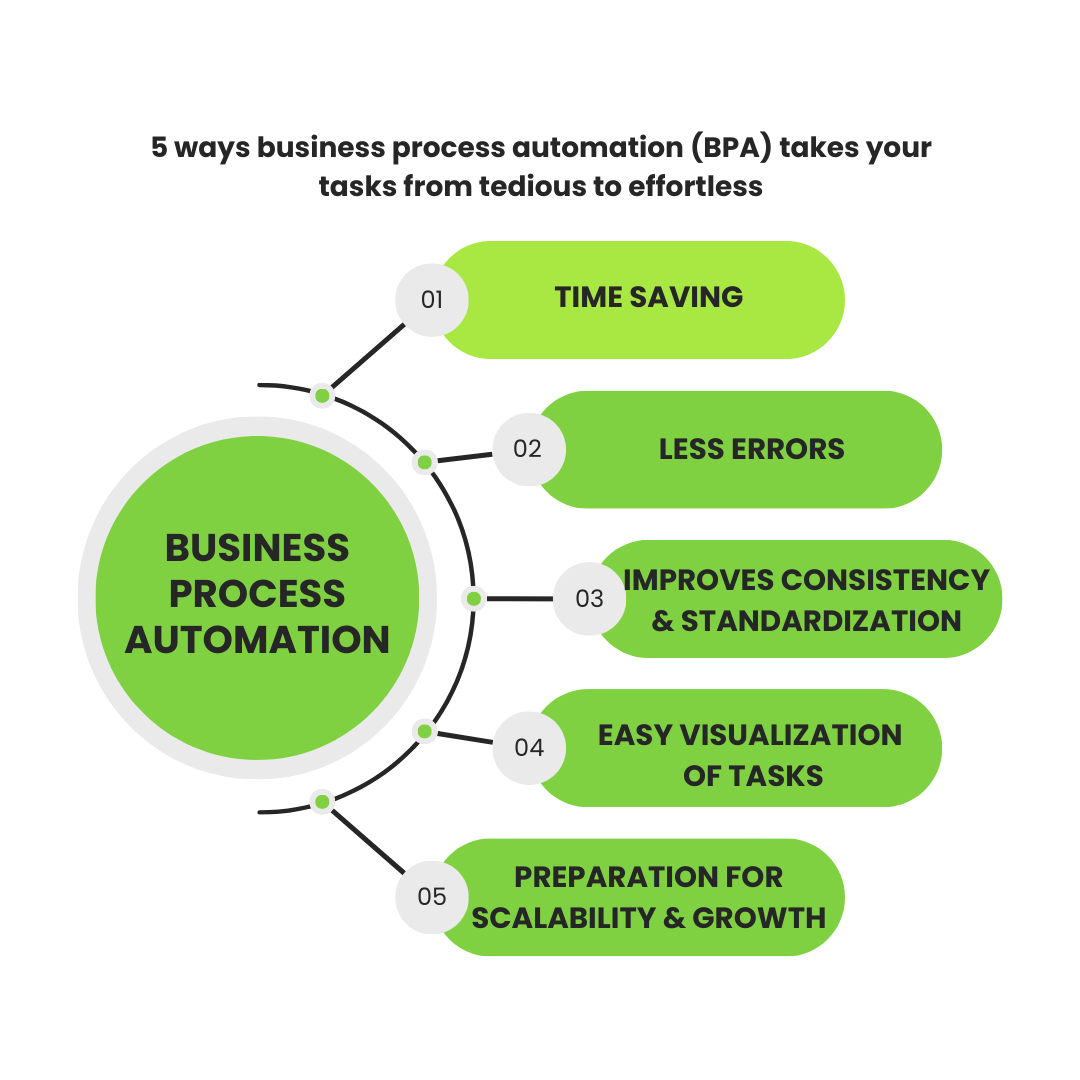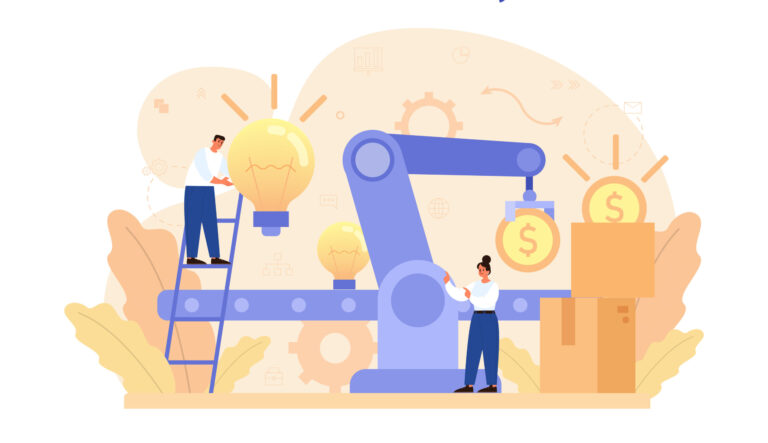If you look up “business process automation,” you’re bound to face tech-heavy definitions and may even leave more confused than when you arrived. But here’s the bottom line: business process automation (BPA) makes your job easier. All of the time-draining, error-prone, or growth-curbing tasks are passed off to software and technology. With BPA your workday is lighter and more streamlined. That’s why 66% of companies automate one or more of their business processes.
In this article, we’re covering:
- A brief overview of what BPA is
- How BPA saves time
- How BPA decreases errors
- How BPA improves consistency and standardization
- How BPA makes it easier to visualize and prioritize tasks
- How BPA prepares your organization for scalability and growth
With BPA, you can picture your business processes like an assembly line. Humans and machines work together, performing specific responsibilities to churn out a consistent product. Customers know exactly what to expect when working with your organization, and team members know precisely how to deliver those expectations.
Here are the five ways automation makes your workday easier. With BPA you can…

Save time
Excited by an enthusiastic new hire? Not so fast: more than half of employees report they’re too busy to do the job they were hired for.
Team members only spend one-third of their time infusing their duties with the creativity and skill that nabbed them the job. Instead, they’re overloaded with meetings, information gathering, chasing approvals, or fiendishly racing to hit the unobtainable inbox zero.
Professor David Graeber has a less-than-reverent definition for these mindless and mundane tasks that steamroll our days. He points to these repetitive responsibilities as the core reason workers find their roles so unfulfilling. Fortunately, they’re the exact tasks automation aces. Use business process automation to fulfill duties like:
- Data entry and extraction
- Generate reports
- Move information between systems
- Collect sign-offs and approvals
- Gather documents
Bogging employees down with these tasks drains more than morale. It has significant cost implications for your organization. According to the Society for Human Resource Management, resignation can cost a company 90–200% of the departing staffer’s salary. Unsurprisingly, when you expand the hours available to focus on more rewarding projects, employees tend to stick around. By axing the reason 31% of quitters abandon ship, you can foster a more loyal and engaged workforce.
Experience fewer errors
Poor quality data is more than a nuisance—it costs organizations over $3.1 trillion annually (and that’s just in the U.S. alone!) Racking up the losses are endless efforts to fix errors, repair data, and track down information that simply never existed in the first place.

Stumbling across a serious mistake is not only a shock to the system, but can result in serious regulatory fines and bottom-line losses. Ask the department store that misprinted the price of a diamond necklace—sending several $1,500 pieces out the door for a paltry $47 before the error was caught. NASA self-detonated an $18.5 million wayward spacecraft that veered off course due to an errant hyphen.
Automation steps in as the dependable assistant for core processes prone to human error:
- Maintain data integrity
- Pull key information, like pricing, from a central database
- Improve accuracy in calculations
- Validate inputs against specified rules
BPA executes tasks consistently and accurately according to predefined rules. It reduces the risk that problems go unnoticed until something catastrophic happens.
Improve consistency and standardization
A rockstar retiree who “does things their own way” takes the rulebook with them.
A long-term team member forgets to share the know-how locked inside their head.
Or employees develop special shortcuts that only spread through word of mouth—never existing in official documentation.
Despite herculean efforts to the contrary, departing employees can tank organizational consistency. One way to establish firm institutional knowledge is through business process automation. Eliminate variations, improve quality control, and establish an iron-clad operations manual.
By mindfully mapping processes, you can create a record of how everything gets done from start to finish. The blueprint for success remains intact—even as employees come and go. Team members no longer specify the methodology for work—automated processes run the show.
Easily visualize and prioritize tasks
We think we have a solid understanding of our job role—but we hit a stumbling block. And one of the most common ones is our mind’s blurry picture of the future. When our brains have trouble visualizing how to get from Point A to Point Z, they tend to short-circuit.
It’s why it feels challenging to start a fitness routine, stick to a diet, or invest.
To some, future planning is a breeze.
But for others, it’s an exhausting mental hurdle that significantly slashes our output. According to Harvard Business Review, when we feel overwhelmed by work, we overestimate how much time and effort projects take. Even worse, we behave as though our exaggerations are true.
On a granular scale, it seems like a personal challenge for a team member to tackle. But the issue quickly saps productivity when scaled across large departments and global organizations. So automation signs on as a brain hack for productivity.
Mapping out all the steps involved in a process gives us a strong visual of the workload. We see exactly what tasks we need to take on, which ones our co-workers will manage, and the software and apps that’ll handle others along the way. We can easily see what we need to do now (supported by automated reminders and nudges) and save thinking about other tasks until the right time. Automation breaks large, unwieldy processes into small, simple steps, creating a traceable system of waypoints that makes it much easier for us to perform.
Prepare your organization for scalability and growth
There’s a point in every organization where manual tasks become unmanageable. Here’s where business process automation steps in to facilitate scalable growth.
- Handle workloads without requiring additional resources: Move into new markets, expand your customer base, or manage larger-than-normal orders. With automated processes in place, it’s easier than ever to navigate dynamic business requirements.
- All processes are governed by business rules: When the market shifts or new regulations come along, you don’t need to reinvent the wheel. Just make a few changes in your business process management software.
- Reuse parts of a process to build completely new ones—and fast: With modular architecture, you can borrow independent components from larger processes and quickly slide them into new ones.
BPA provides scalability and flexibility by easily adapting to changing business needs.
Best business process automation (BPA) software
Overall, business process automation simplifies your job by reducing manual effort, minimizing errors, improving consistency, providing better task management, and accommodating growth and change. By embracing BPA, you can focus on higher-value activities, enhance productivity, and achieve better outcomes in your work. Chat with us to learn more about BPA and which software is right for you. At the end of the day, your company deserves to find the right fit, even if it isn’t us!





